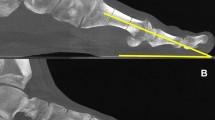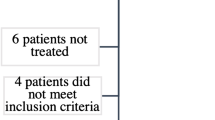Abstract
Purpose
To verify if indirect radiographic signs of first metatarsal pronation, determined by the head round sign, correspond to weight-bearing computed tomography (WBCT) measurements.
Methods
In this case–control retrospective study, we analyzed 26 hallux valgus (HV) feet and 20 controls through conventional radiograph (CR) and WBCT images. Two blinded orthopaedic foot and ankle surgeons performed the measurements. Pronation classification (head roundness), head diameter (HD), traditional HV angles, arthritis, sesamoid positioning, and first metatarsal rotation angle (MRA) (alpha angle) were evaluated. Comparisons were performed by Student’s T-test and a multivariate regression was executed. P-values less than 0.05 were considered significant.
Results
Mean values were higher in HV patients than controls when evaluating MRA (11.51 [9.42–13.60] to 4.23 [1.84–6.62], 95%CI), HD (22.35 [21.52–23.18] to 21.01 [20.07–21.96]), and sesamoid rotation angle (SRA) (26.72 [24.09–29.34] to 4.56 [1.63–7.50]). The MRA had a low influence in head roundness classification (R2: 0.15). Changes in the pronation classification were explained chiefly by the sesamoid station (SS) (R2: 0.37), where stations 4 to 7 were found to be strong predictors of roundness classifications 2 and 3.
Conclusion
Indirect signs of metatarsal pronation, determined by the head round sign, correlate weakly with the alpha angle measured in WBCT. The presence of arthritis and sesamoids displacement might modify the perception of first head roundness. The influence of MRA in the classification was low, where SS from 4 to 7 was strong predictors of a higher pronation classification.



Similar content being viewed by others
References
Okuda R, Kinoshita M, Yasuda T, Jotoku T, Kitano N, Shima H (2007) The shape of the lateral edge of the first metatarsal head as a risk factor for recurrence of hallux valgus. J Bone Joint Surg Am 89:2163–2172. https://doi.org/10.2106/JBJS.F.01455
Wagner E, Wagner P (2020) Metatarsal pronation in hallux valgus deformity: a review. J Am Acad Orthop Surg Glob Res Rev 4(6):e20.00091. https://doi.org/10.5435/JAAOSGlobal-D-20-00091
Cruz EP, Wagner FV, Henning C, Sanhudo JAV, Pagnussato F, Galia CR (2019) Does hallux valgus exhibit a deformity inherent to the first metatarsal bone? J Foot Ankle Surg 58:1210–1214. https://doi.org/10.1053/j.jfas.2018.09.031
Wagner P, Wagner E (2018) Is the rotational deformity important in our decision-making process for correction of hallux valgus deformity? Foot Ankle Clin 23:205–217. https://doi.org/10.1016/j.fcl.2018.01.009
Saltzman CL, Brandser EA, Anderson CM, Berbaum KS, Brown TD (1996) Coronal plane rotation of the first metatarsal. Foot Ankle Int 17:157–161. https://doi.org/10.1177/107110079601700307
Mortier JP, Bernard JL, Maestro M (2012) Axial rotation of the first metatarsal head in a normal population and hallux valgus patients. Orthop Traumatol Surg Res 98:677–683. https://doi.org/10.1016/j.otsr.2012.05.005
Yamaguchi S, Sasho T, Endo J, Yamamoto Y, Akagi R, Sato Y, Takahashi K (2015) Shape of the lateral edge of the first metatarsal head changes depending on the rotation and inclination of the first metatarsal: a study using digitally reconstructed radiographs. J Orthop Sci 20:868–874. https://doi.org/10.1007/s00776-015-0749-x
Prado M, Baumfeld T, Nery C, Mendes A, Baumfeld D (2020) Rotational biplanar Chevron osteotomy. Foot Ankle Surg 26:473–476. https://doi.org/10.1016/j.fas.2019.05.011
Dayton P, Feilmeier M (2017) Comparison of tibial sesamoid position on anteroposterior and axial radiographs before and after triplane tarsal metatarsal joint arthrodesis. J Foot Ankle Surg 56:1041–1046. https://doi.org/10.1053/j.jfas.2017.05.006
Talbot KD, Saltzman CL (1997) Hallucal rotation: a method of measurement and relationship to bunion deformity. Foot Ankle Int 18:550–556. https://doi.org/10.1177/107110079701800904
Steadman J, Barg A, Saltzman CL (2021) First metatarsal rotation in hallux valgus deformity. Foot Ankle Int 42:510–522. https://doi.org/10.1177/1071100721997149
Kim Y, Kim JS, Young KW, Naraghi R, Cho HK, Lee SY (2015) A new measure of tibial sesamoid position in hallux valgus in relation to the coronal rotation of the first metatarsal in CT scans. Foot Ankle Int 36:944–952. https://doi.org/10.1177/1071100715576994
Mahmoud K, Metikala S, Mehta SD, Fryhofer GW, Farber DC, Prat D (2021) The role of weightbearing computed tomography scan in hallux valgus. Foot Ankle Int 42:287–293. https://doi.org/10.1177/1071100720962398
Steadman J, Bakshi N, Arena C, Leake R, Barg A, Saltzman CL (2021) Normative distribution of first metatarsal axial rotation. Foot Ankle Int. https://doi.org/10.1177/10711007211001015
Conti MS, Patel TJ, Caolo KC, Amadio JM, Miller MC, Costigliola SV, Ellis SJ, Conti SF (2021) Correlation of different methods of measuring pronation of the first metatarsal on weightbearing CT scans. Foot Ankle Int. https://doi.org/10.1177/10711007211003090
Bolzinger M, Thevenin-Lemoine C, Gallini A, Gauzy JS (2021) Abnormalities in distal first metatarsal joint surface orientation: Distal Metatarsal Articular Angle and Distal Metatarsal-2 Articular Angle. Orthop Traumatol Surg Res 22:102938. https://doi.org/10.1016/j.otsr.2021.102938
Lee KM, Ahn S, Chung CY, Sung KH, Park MS (2012) Reliability and relationship of radiographic measurements in hallux valgus. Clin Orthop Relat Res 470:2613–2621. https://doi.org/10.1007/s11999-012-2368-6
Cakmak G, Kanatlı U, Kılınç B, Yetkin H (2013) The effect of pronation and inclination on the measurement of the hallucal distal metatarsal articular set angle. Acta Orthop Traumatol Turc 47:354–358. https://doi.org/10.3944/aott.2013.2669
Hardy RH, Clapham JC (1951) Observations on hallux valgus; based on a controlled series. J Bone Joint Surg Br 33-b:376–391. https://doi.org/10.1302/0301-620x.33b3.376
Welck MJ, Singh D, Cullen N, Goldberg A (2018) Evaluation of the 1st metatarso-sesamoid joint using standing CT - the Stanmore classification. Foot Ankle Surg 24:314–319. https://doi.org/10.1016/j.fas.2017.03.005
Ono Y, Yamaguchi S, Sadamasu A, Kimura S, Watanabe S, Akagi R, Sasho T, Ohtori S (2020) The shape of the first metatarsal head and its association with the presence of sesamoid-metatarsal joint osteoarthritis and the pronation angle. J Orthop Sci 25:658–663. https://doi.org/10.1016/j.jos.2019.06.013
Coughlin MJ, Saltzman CL, Nunley JA 2nd (2002) Angular measurements in the evaluation of hallux valgus deformities: a report of the ad hoc committee of the American Orthopaedic Foot & Ankle Society on angular measurements. Foot Ankle Int 23:68–74. https://doi.org/10.1177/107110070202300114
Coughlin MJ, Shurnas PS (2003) Hallux rigidus: demographics, etiology, and radiographic assessment. Foot Ankle Int 24:731–743. https://doi.org/10.1177/107110070302401002
Van Deventer SJ, Strydom A, Saragas NP, Ferrao PNF (2020) Morphology of the first metatarsal head as a risk factor for hallux valgus interphalangeus. Foot Ankle Surg 26:105–109. https://doi.org/10.1016/j.fas.2018.12.004
Cheung ZB, Myerson MS, Tracey J, Vulcano E (2018) Weightbearing CT scan assessment of foot alignment in patients with hallux rigidus. Foot Ankle Int 39:67–74. https://doi.org/10.1177/1071100717732549
Apostle KL, Coleman NW, Sangeorzan BJ (2014) Subtalar joint axis in patients with symptomatic peritalar subluxation compared to normal controls. Foot Ankle Int 35:1153–1158. https://doi.org/10.1177/1071100714546549
Wagner P, Wagner E (2019) The use of a triplanar metatarsal rotational osteotomy to correct hallux valgus deformities. JBJS Essent Surg Tech 9(4):e43 1-2. https://doi.org/10.2106/JBJS.ST.19.00010
Choi JY, Ahn HC, Baek HS, Park JH, Suh JS (2019) Factors influencing medial sesamoid arthritis in patients with hallux valgus deformity: magnetic resonance imaging evaluation. Foot Ankle Surg 25:612–617. https://doi.org/10.1016/j.fas.2018.06.003
Eustace S, O’Byrne J, Stack J, Stephens MM (1993) Radiographic features that enable assessment of first metatarsal rotation: the role of pronation in hallux valgus. Skeletal Radiol 22:153–156. https://doi.org/10.1007/BF00206143
Yildirim Y, C¸Abukoglu C, Erol B, Esemenli T, (2005) Effect of metatarsophalangeal joint position on the reliability of the tangential sesamoid view in determining sesamoid position. Foot Ankle Int 26:247–250. https://doi.org/10.1177/107110070502600311
Campbell B, Miller MC, Williams L, Conti SF (2018) Pilot study of a 3-dimensional method for analysis of pronation of the first metatarsal of hallux valgus patients. Foot Ankle Int 39:1449–1456. https://doi.org/10.1177/1071100718793391
Najefi AA, Zaveri A, Alsafi MK, Malhotra K, Patel S, Cullen N, Welck M (2021) The Assessment of First Metatarsal Rotation in the Normal Adult Population Using Weightbearing Computed Tomography. Foot Ankle Int 13:10711007211015187. https://doi.org/10.1177/10711007211015187
Robinson AH, Cullen NP, Chhaya NC, Sri-Ram K, Lynch A (2006) Variation of the distal metatarsal articular angle with axial rotation and inclination of the first metatarsal. Foot Ankle Int 27:1036–1040. https://doi.org/10.1177/107110070602701207
Dibbern KN, Li S, Vivtcharenko V, Auch E, Lintz F, Ellis SJ, Femino JE, de Cesar Netto C (2021) Three-Dimensional Distance and Coverage Maps in the Assessment of Peritalar Subluxation in Progressive Collapsing Foot Deformity. Foot Ankle Int 42(6):757–767. https://doi.org/10.1177/1071100720983227
Author information
Authors and Affiliations
Contributions
Nacime Salomão Barbachan Mansur: had full access to all the data in the study and takes responsibility for the integrity and accuracy of the data analysis, literature revision, study design, writing, paper submissions, and data collecting.
Matthieu Lalevee: co-supervisor, writing, data collecting, and paper submission.
Eli Schmidt: literature revision, writing.
Kevin Dibbern: literature revision, writing.
Pablo Wagner: literature revision, writing.
Emilio Wagner: literature revision, writing.
Caio Nery: literature revision, writing.
Cesar de Cesar Netto: supervisor, literature revision, writing, study design, and paper submissions.
Each author contributed to the refinement of the study protocol and approved the final manuscript.
Corresponding author
Ethics declarations
Ethics and means of dissemination
University Ethics Committee approved this research under the number 202012422 in accordance with the Declaration of Helsinki.
Competing interests
Nacime Salomao Barbachan Mansur, MD, PhD (Brazil): Brazilian Foot and Ankle Society: Board or committee member. Pablo Wagner, MD (Chile); DePuy, A Johnson & Johnson Company: other financial or material support Elsevier: Editorial or governing board paragon28: IP royalties. Emilio Wagner, MD: Arthrex, Inc: Paid consultant DePuy, A Johnson & Johnson Company: Other financial or material support; Research support Paragon28: IP royalties Promedon Chile: Other financial or material support. Caio Augusto de Souza Nery, MD, PhD (Brazil): Arthrex: Paid presenter or speaker. Cesar De Cesar Netto, MD, PhD (Iowa City, IA): American Orthopaedic Foot and Ankle Society: Board or committee member CurveBeam: Paid consultant; Stock or stock Options Foot and Ankle International: Editorial or governing board Nextremity: Paid consultant Ossio: Paid consultant Paragon 28: IP royalties; Paid consultant Weightbearing CT International Study Group: Board or committee member Zimmer: Paid consultant. The other authors have nothing to disclose.
Disclaimer
The cited companies did not finance the study or participate in any phase of its conduction. The implants used in this study were from several companies as the surgeries were performed at a public hospital.
Data sharing
According to the ICMJE data sharing police, core records will be shared through Mendeley Data and available upon request.
Additional information
Publisher’s note
Springer Nature remains neutral with regard to jurisdictional claims in published maps and institutional affiliations.
Level of Evidence: Level III, Retrospective Diagnostic Study
Supplementary Information
Below is the link to the electronic supplementary material.
Rights and permissions
About this article
Cite this article
Mansur, N.S.B., Lalevee, M., Schmidt, E. et al. Correlation between indirect radiographic parameters of first metatarsal rotation in hallux valgus and values on weight-bearing computed tomography. International Orthopaedics (SICOT) 45, 3111–3118 (2021). https://doi.org/10.1007/s00264-021-05136-9
Received:
Accepted:
Published:
Issue Date:
DOI: https://doi.org/10.1007/s00264-021-05136-9




